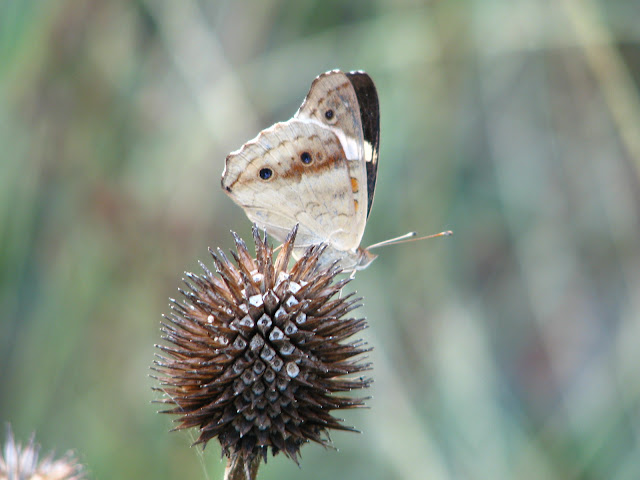Since we had so much rain over the last couple of weeks, I thought this would be a good time to post about my rain gardens. A rain garden is simply a planted depression that collects rainwater runoff before it leaves the property and allows it to soak into the ground rather than entering the sewer system. A rain garden usually holds water for no more than a few hours, which is not long enough for mosquitoes to develop. Rain gardens are planted with plants that can endure brief periods of wet soil followed by longer periods of dry soil.
The first three pictures are of my front yard rain garden. It is situated on the lowest point in the front yard and built up on two sides with large boulders. To create a depression, I dug out several wheel barrels of soil. I used the soil I removed to grade the other side of the front yard. I did not do much to prepare the depression for planting other than mixing in a couple of bags of compost and expanded shale.
The gutters on this end of the house are connected to underground pipes that empty in the rain garden. It is recommended that you use plants that can tolerate moister soil on the bottom of the rain garden and plants that need drier conditions on the sides. My rain garden dries out quickly, so it includes some surprising plants throughout. I consider the shade from the neighbor's live oak to be a greater limiting factor than the amount of moisture in the soil, although I would never put a xeric plant like a cactus or agave in a rain garden.

The plants in the front rain garden include False Indigo, Amorpha fruticosa, Heartleaf Skullcap, Scutellaria ovata, Gregg's Mistflower, Conoclinium greggii, Blue Mistflower, Conoclinium coelestinum, Aromatic Aster, Symphyotrichum oblongifolium, Gayfeather, Liatris mucronata and Liatris Spicata, Little Bluestem, Schizachyrium scoparium, Bushy Bluestem, Andropogon glomeratus, Green Milkweed, Asclepias viridis, and a variety of other plants that reseeded in the rain garden.
I also added a rain garden in the lowest point of the backyard. This rain garden is filled by underground pipes that collect rainwater from the gutters on the back of the house. Plants in this rain garden include Weeping Yaupon, Ilex vomitoria 'Pendula', Big Muhly, Muhlenbergia lindheimeri, Seep Muhly, Muhlenbergia reverchonii, Giant Coneflower, Rudbeckia maxima, Gulf Coast Penstemon, Penstemon tenuis, Cherokee Sedge, Carex cherokeensis, Frogfruit, Phyla nodiflora, and a few other miscellaneous plants.
And what do April showers and thunderstorms bring besides hail claims? May April flowers!
Most of the plants have recovered from the hail storms and are blooming away, like the Autumn Sage and Gulf Coast Penstemon in the background. The Gregg's Mistflower around the birdbath have yet to begin blooming.
The Bluebonnets are on the decline, but still look good. The golden flowers of Four Nerve Daisy brighten the scene.
More Bluebonnets and Gulf Coast Penstemon bloom around the prickly Toothache Tree. The Toothache Tree just finished producing its fragrant (in a good way) flowers.
My unidentified giant Hesperaloe will be blooming soon.
I may have to get a tall ladder to get a good look at the flowers. The will be forming 8-10 feet above the ground. Unfortunately, the Hesperaloe is a little too close to the Toothache Tree and the flowers will eventually be in the canopy of the tree. I may have to try to move or divide the Hesperaloe one of these days.
The larger of the Pale-Leaf Yuccas is in bloom.
The stress of being pounded by hail in mid-March may have attracted a new predator to my yuccas. The leaves of my Pale-Leaf Yucca and Yucca Gloriosa are covered with little beetles that I think are Yucca Plant Bugs. I will spray some light horticultural oil on them this weekend to see if that will get them under control. Has anyone experienced this beast before?
A few more shots from the front garden...
The next rounds of blooms are getting ready to open. These are the closed flowers of Antelope Horns Milkweed.
And this is the first flower of Narrowleaf Coneflower.
More rain and storms are expected throughout the day on Friday. It has been a stormy spring. Let's hope the weather begins to settle down soon.





























































